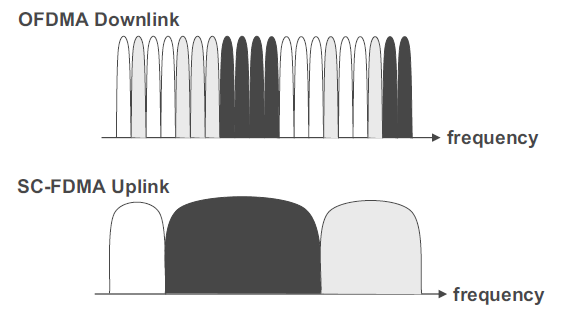Adopting a multicarrier approach for multiple access in LTE was the first major design choice. After initial consolidation of proposals, the candidate schemes for the downlink were Orthogonal Frequency-Division Multiple Access (OFDMA)8 and Multiple WCDMA, while the candidate schemes for the uplink were Single-Carrier Frequency-Division Multiple Access (SC-FDMA), OFDMA and Multiple WCDMA. The choice of multiple-access schemes was made in December 2005, with OFDMA being selected for the downlink, and
SC-FDMA for the uplink. Both of these schemes open up the frequency domain as a new dimension of flexibility in the system, as illustrated schematically in below figure: -

OFDMA extends the multicarrier technology OFDM to provide a very flexible multipleaccess scheme. OFDM subdivides the bandwidth available for signal transmission into a multitude of narrowband subcarriers, arranged to be mutually orthogonal, which either individually or in groups can carry independent information streams; in OFDMA, this subdivision of the available bandwidth is exploited in sharing the subcarriers among multiple users.
*This resulting flexibility can be used in various ways:*
• Different spectrum bandwidths can be utilized without changing the fundamental
system parameters or equipment design.
• Transmission resources of variable bandwidth can be allocated to different users and
scheduled freely in the frequency domain.
• Fractional frequency re-use and interference coordination between cells are facilitated.
Extensive experience with OFDM has been gained in recent years from deployment of digital audio and video broadcasting systems such as DAB, DVB and DMB.10 This experience has highlighted some of the key advantages of OFDM, which include:
• robustness to time-dispersive radio channels, thanks to the subdivision of the wideband
transmitted signal into multiple narrowband subcarriers, enabling inter-symbol
interference to be largely constrained within a guard interval at the beginning of each
symbol;
• low-complexity receivers, by exploiting frequency-domain equalization;
• simple combining of signals from multiple transmitters in broadcast networks.
By contrast, the transmitter design for OFDM is more costly, as the Peak-to-Average Power Ratio (PAPR) of an OFDM signal is relatively high, resulting in a need for a highlylinear RF power amplifier. However, this limitation is not inconsistent with the use of OFDM for downlink transmissions, as low-cost implementation has a lower priority for the base station than for the mobile terminal.
In the uplink, however, the high PAPR of OFDM is difficult to tolerate for the transmitter of the mobile terminal, since it is necessary to compromise between the output power required for good outdoor coverage, the power consumption, and the cost of the power amplifier. SCFDMA provides a multiple-access technology. Which has much in common with OFDMA – in particular the flexibility in the frequency
domain, and the incorporation of a guard interval at the start of each transmitted symbol to facilitate low-complexity frequency-domain equalization at the receiver. At the same time, SC-FDMA has a significantly lower PAPR. It therefore resolves to some extent the dilemma of how the uplink can benefit from the advantages of multicarrier technology while avoiding excessive cost for the mobile terminal transmitter and retaining a reasonable degree of commonality between uplink and downlink technologies.
